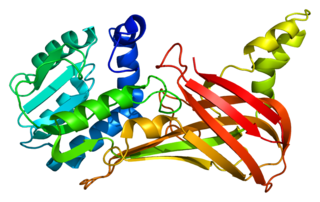Related Research Articles

Vacuolar-sorting protein SNF8 is a protein that in humans is encoded by the SNF8 gene.

snRNA-activating protein complex subunit 4 is a protein that in humans is encoded by the SNAPC4 gene.

General transcription factor 3C polypeptide 5 is a protein that in humans is encoded by the GTF3C5 gene.

Pseudouridylate synthase 7 homolog-like protein is an enzyme that in humans is encoded by the PUS7L gene.

STAGA complex 65 subunit gamma is a protein that in humans is encoded by the SUPT7L gene.

Protein arginine N-methyltransferase 3 is an enzyme that in humans is encoded by the PRMT3 gene.

HMG box transcription factor BBX also known as bobby sox homolog or HMG box-containing protein 2 is a protein that in humans is encoded by the BBX gene.

Integrator complex subunit 12 (Int12) also known as PHD finger protein 22 (PHF22) is a protein that in humans is encoded by the INTS12 gene.

Protein FAM134C is a protein that in humans is encoded by the FAM134C gene.

tripartite motif containing 45, also known as TRIM45, is a human gene.

Dynactin 5 (p25) is a protein that in humans is encoded by the DCTN5 gene.

MDN1, midasin homolog (yeast) is a protein that in humans is encoded by the MDN1 gene. Midasin is a member AAA ATPase family.

Mitochondrial methionyl-tRNA formyltransferase is a protein that in humans is encoded by the MTFMT gene.
Rtf1, Paf1/RNA polymerase II complex component, homolog is a protein that in humans is encoded by the RTF1 gene.

Coiled-coil domain containing 137 is a protein that in humans is encoded by the CCDC137 gene.
Protein arginine methyltransferase 8 is a protein that in humans is encoded by the PRMT8 gene. Arginine methylation is a posttranslational modification involved in a number of cellular processes, including DNA repair, RNA transcription, signal transduction and protein compartmentalization. PRMT8 binds and dimethylates Ewing sarcoma breakpoint region 1 (EWS) protein.

Spinster homolog 2 (Drosophila) is a protein that in humans is encoded by the SPNS2 gene.

DIP2 disco-interacting protein 2 homolog B (Drosophila) is a protein that in humans is encoded by the DIP2B gene. A member of the disco-interacting protein homolog 2 protein family, it contains a binding site for the transcriptional regulator DNA methyltransferase 1 associated protein 1, as well as AMP-binding sites. The presence of these sites suggests that DIP2B may participate in DNA methylation. This gene is located near a folate-sensitive fragile site.
Asteroid homolog 1 (Drosophila) is a protein that in humans is encoded by the ASTE1 gene. The gene is also known as HT001.

Chromobox homolog 7 is a protein that in humans is encoded by the CBX7 gene. The loss of CBX7 gene expression has been shown to correlate with a malignant form of thyroid cancer.
References
- 1 2 "Glutamyl-tRNA(Gln) amidotransferase, subunit C homolog (bacterial)" . Retrieved 2011-12-07.
- ↑ "Salmonella infection data for Gatc". Wellcome Trust Sanger Institute.
- ↑ "Citrobacter infection data for Gatc". Wellcome Trust Sanger Institute.
- 1 2 3 4 Gerdin AK (2010). "The Sanger Mouse Genetics Programme: High throughput characterisation of knockout mice". Acta Ophthalmologica. 88 (S248). doi:10.1111/j.1755-3768.2010.4142.x. S2CID 85911512.
- ↑ Mouse Resources Portal, Wellcome Trust Sanger Institute.
- ↑ "International Knockout Mouse Consortium".
- ↑ "Mouse Genome Informatics".
- ↑ Skarnes, W. C.; Rosen, B.; West, A. P.; Koutsourakis, M.; Bushell, W.; Iyer, V.; Mujica, A. O.; Thomas, M.; Harrow, J.; Cox, T.; Jackson, D.; Severin, J.; Biggs, P.; Fu, J.; Nefedov, M.; De Jong, P. J.; Stewart, A. F.; Bradley, A. (2011). "A conditional knockout resource for the genome-wide study of mouse gene function". Nature. 474 (7351): 337–342. doi:10.1038/nature10163. PMC 3572410 . PMID 21677750.
- ↑ Dolgin E (June 2011). "Mouse library set to be knockout". Nature. 474 (7351): 262–3. doi:10.1038/474262a. PMID 21677718.
- ↑ Collins FS, Rossant J, Wurst W (January 2007). "A mouse for all reasons". Cell. 128 (1): 9–13. doi: 10.1016/j.cell.2006.12.018 . PMID 17218247. S2CID 18872015.
- ↑ van der Weyden L, White JK, Adams DJ, Logan DW (2011). "The mouse genetics toolkit: revealing function and mechanism". Genome Biol. 12 (6): 224. doi: 10.1186/gb-2011-12-6-224 . PMC 3218837 . PMID 21722353.